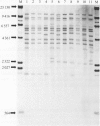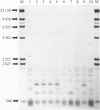Abstract
Restriction fragment length polymorphism of the gene encoding rRNA (ribotyping) was used in combination with conventional epidemiological markers to study phenotypic variations among Streptococcus agalactiae of bovine origin and the possible epidemiological interrelationship between the bovine and human reservoirs of Streptococcus agalactiae. The bovine material constituted 53 strains (9 antigen combinations) isolated from 11 herds. Herds with a uniform as well as heterogenic antigenic pattern were included. Furthermore, strains isolated in the course of time from the same persistently infected quarters were examined. The human material constituted 16 strains, 4 each of 4 serotypes, isolated from healthy carriers. Finally, nine serotype- and the group reference strains were examined. All strains were serotyped by double diffusion in agarose gel, biotyped (lactose +/-), and ribotyped using two restriction enzymes, Hind III and HhaI. All isolates could be typed by ribotyping and seven ribotypes were identified among the reference strains. The restriction enzymes used alone or in combination gave typing results that allowed discrimination between and within serotype. Combined use of serotype, Hind III and HhaI ribotypes produced 11 types among the 16 human strains. Ribotype analysis discriminated between herds infected with the same serotype. Strains of varying antigenic patterns from the same herd had the same ribotype. Phenotypic variations in serotype observed in persistent intramammary infection were not related to genetic changes as monitored by ribotype. Two ribotypes were represented among both bovine and human strains. The discriminating capability of lactose fermentation was of limited value.
Full text
PDF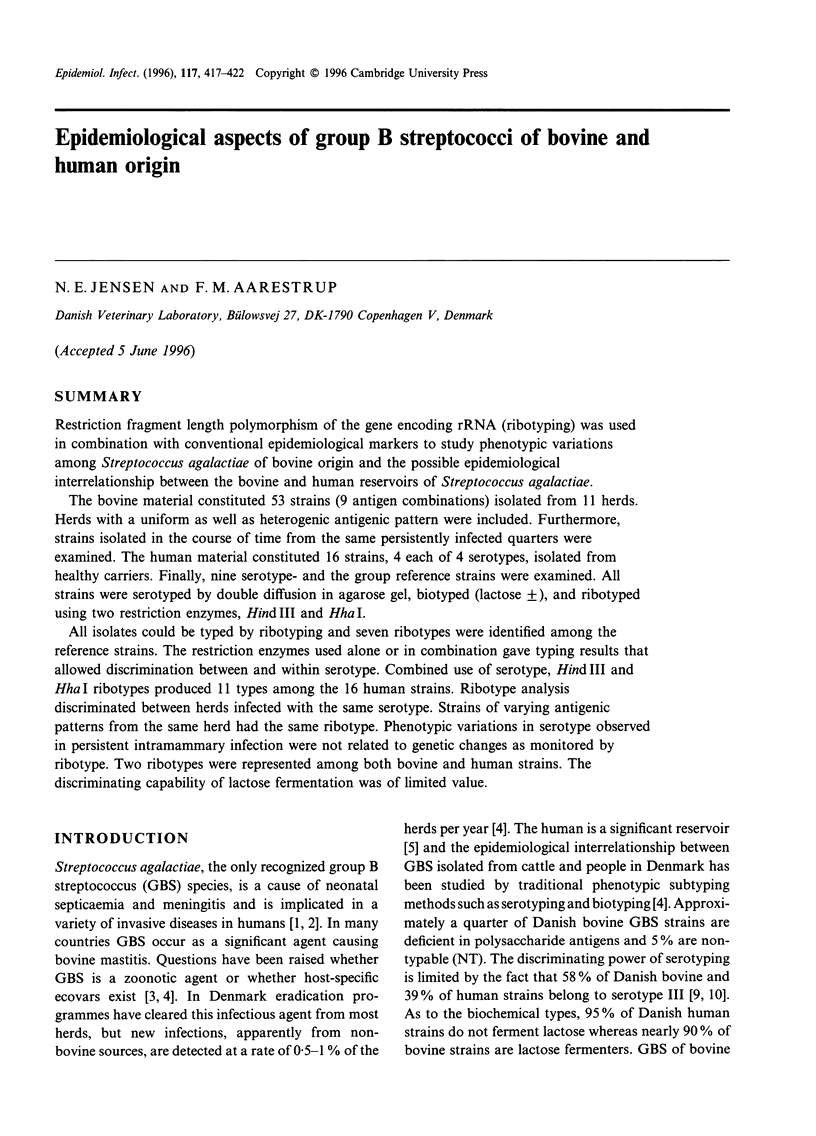
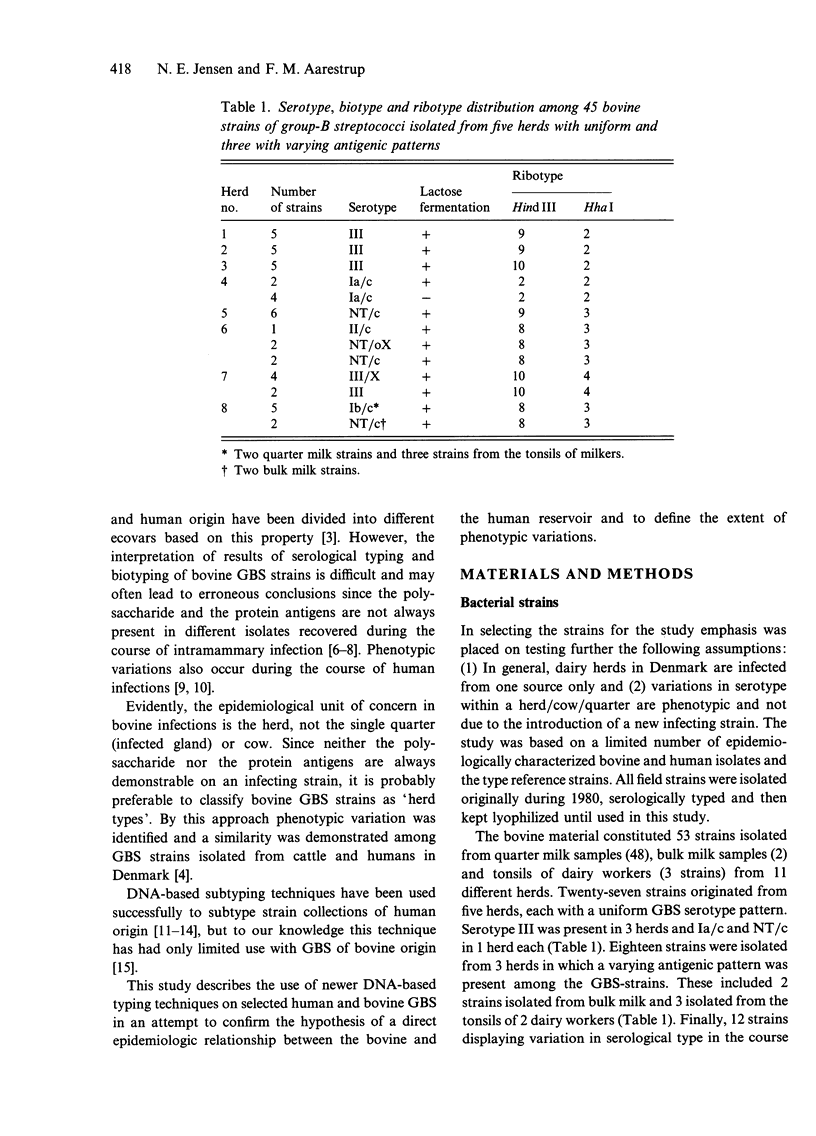
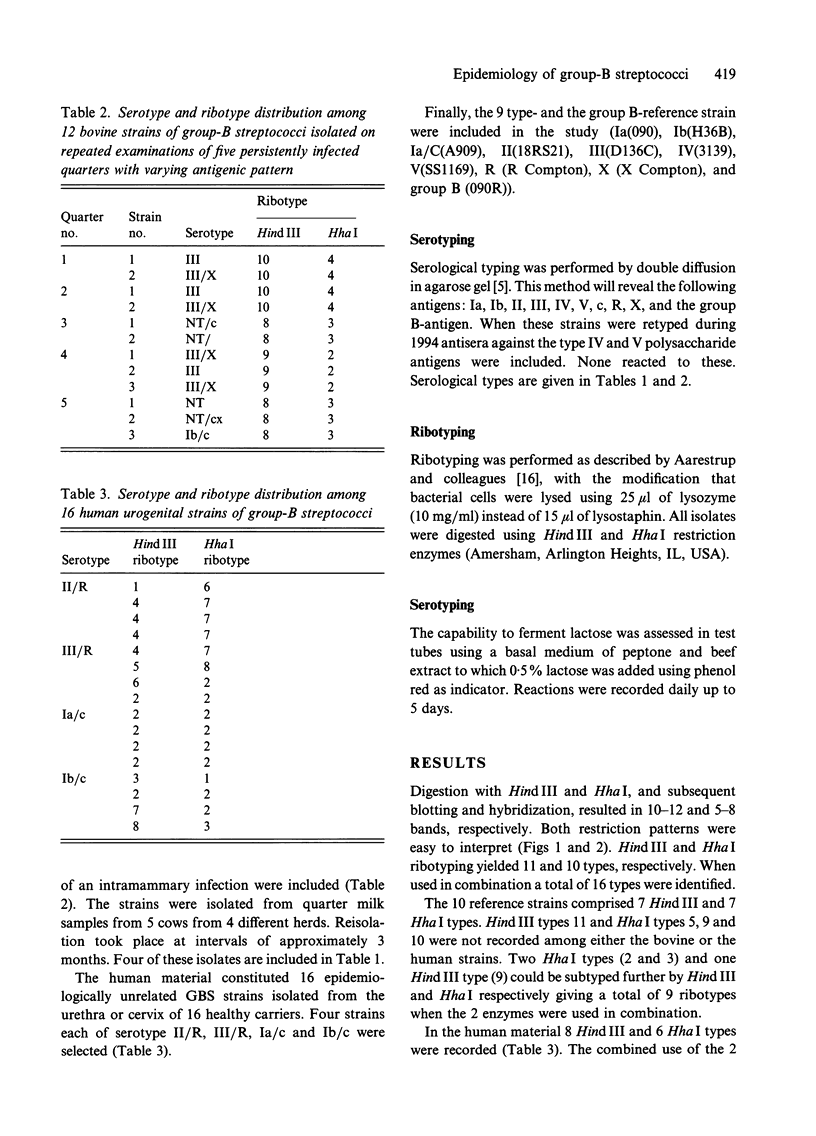
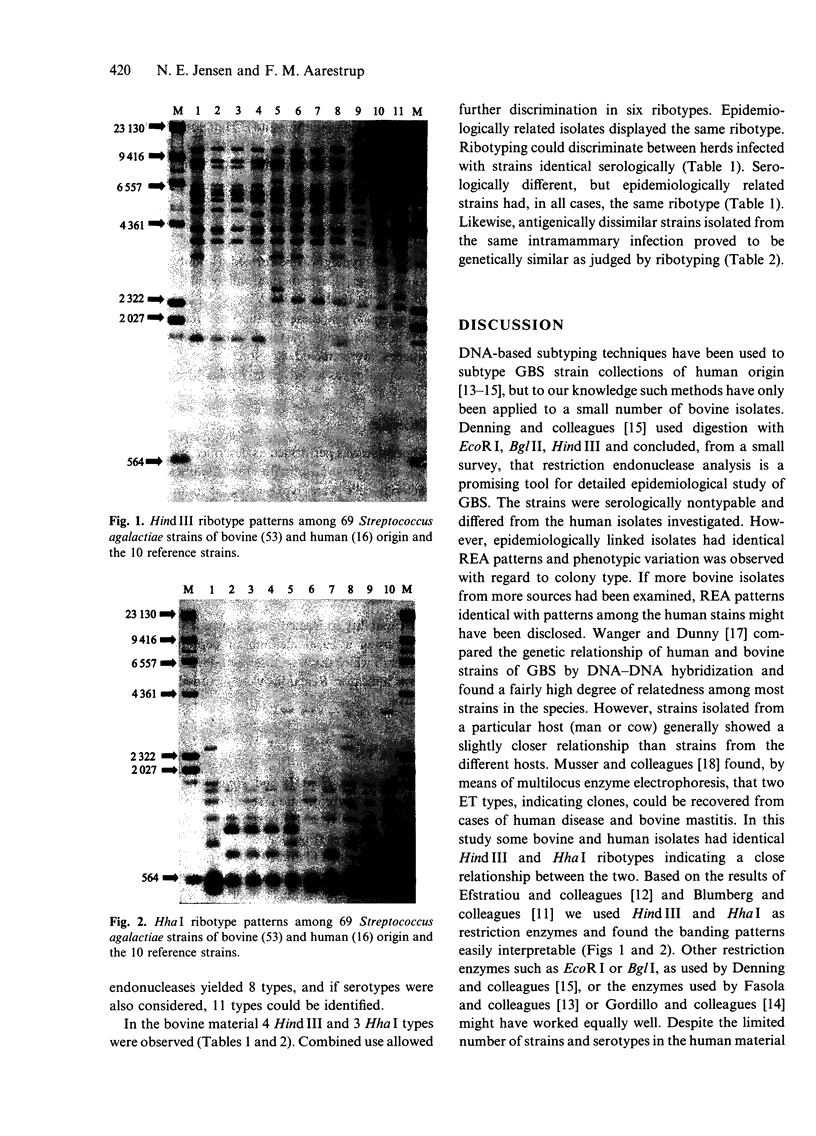
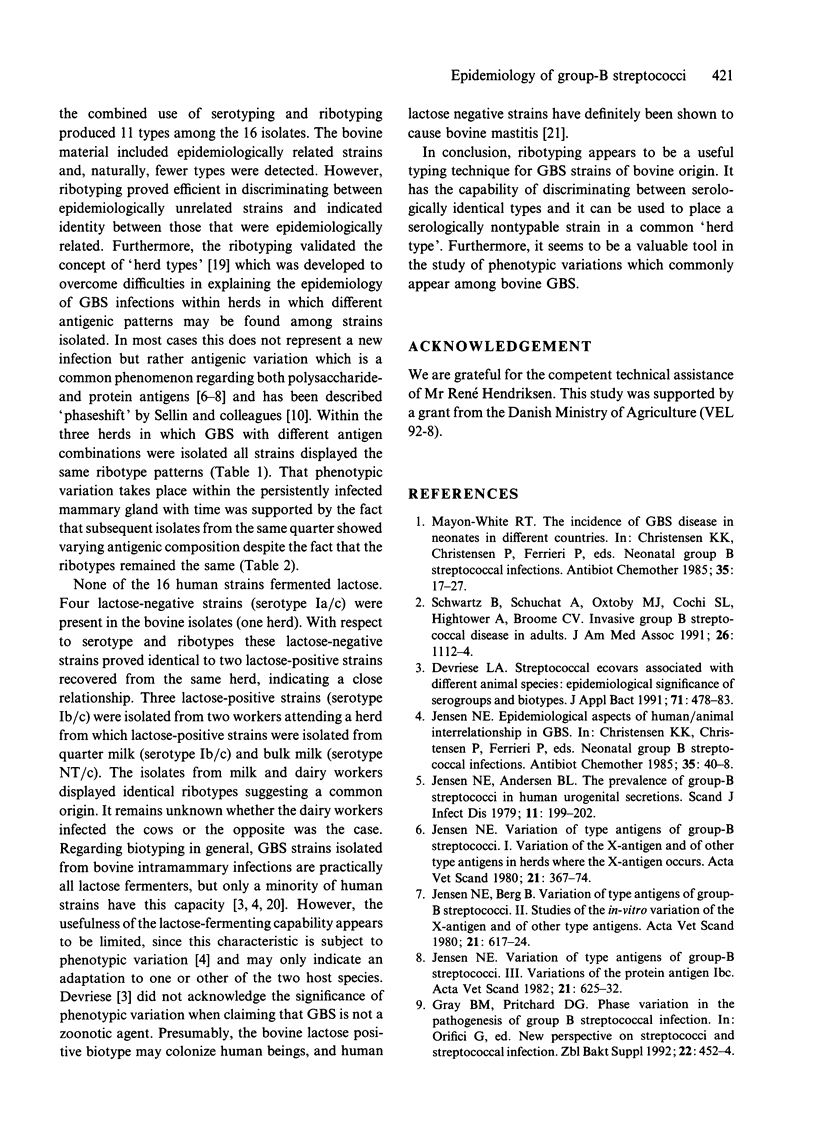
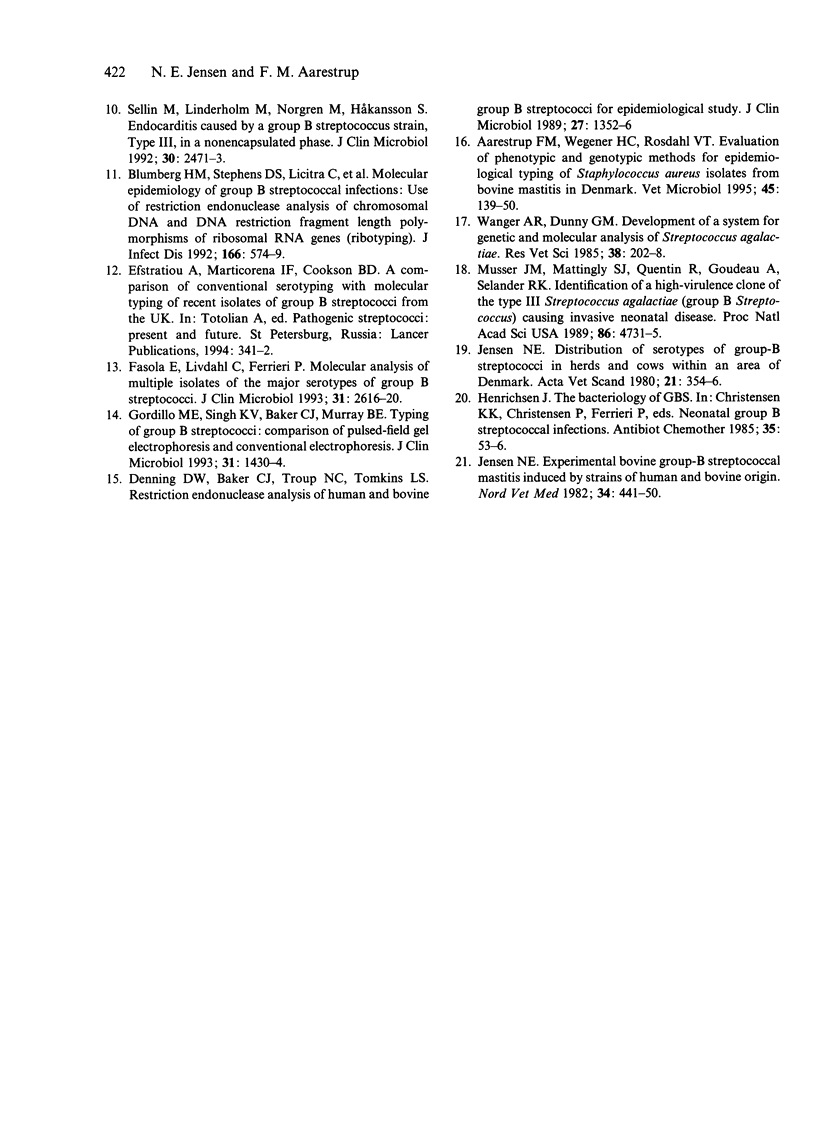
Images in this article
Selected References
These references are in PubMed. This may not be the complete list of references from this article.
- Aarestrup F. M., Wegener H. C., Rosdahl V. T. Evaluation of phenotypic and genotypic methods for epidemiological typing of Staphylococcus aureus isolates from bovine mastitis in Denmark. Vet Microbiol. 1995 Jul;45(2-3):139–150. doi: 10.1016/0378-1135(95)00043-a. [DOI] [PubMed] [Google Scholar]
- Blumberg H. M., Stephens D. S., Licitra C., Pigott N., Facklam R., Swaminathan B., Wachsmuth I. K. Molecular epidemiology of group B streptococcal infections: use of restriction endonuclease analysis of chromosomal DNA and DNA restriction fragment length polymorphisms of ribosomal RNA genes (ribotyping). J Infect Dis. 1992 Sep;166(3):574–579. doi: 10.1093/infdis/166.3.574. [DOI] [PubMed] [Google Scholar]
- Denning D. W., Baker C. J., Troup N. J., Tompkins L. S. Restriction endonuclease analysis of human and bovine group B streptococci for epidemiologic study. J Clin Microbiol. 1989 Jun;27(6):1352–1356. doi: 10.1128/jcm.27.6.1352-1356.1989. [DOI] [PMC free article] [PubMed] [Google Scholar]
- Devriese L. A. Streptococcal ecovars associated with different animal species: epidemiological significance of serogroups and biotypes. J Appl Bacteriol. 1991 Dec;71(6):478–483. doi: 10.1111/j.1365-2672.1991.tb03821.x. [DOI] [PubMed] [Google Scholar]
- Fasola E., Livdahl C., Ferrieri P. Molecular analysis of multiple isolates of the major serotypes of group B streptococci. J Clin Microbiol. 1993 Oct;31(10):2616–2620. doi: 10.1128/jcm.31.10.2616-2620.1993. [DOI] [PMC free article] [PubMed] [Google Scholar]
- Gordillo M. E., Singh K. V., Baker C. J., Murray B. E. Typing of group B streptococci: comparison of pulsed-field gel electrophoresis and conventional electrophoresis. J Clin Microbiol. 1993 Jun;31(6):1430–1434. doi: 10.1128/jcm.31.6.1430-1434.1993. [DOI] [PMC free article] [PubMed] [Google Scholar]
- Henrichsen J. The bacteriology of GBS. Antibiot Chemother (1971) 1985;35:53–56. doi: 10.1159/000410360. [DOI] [PubMed] [Google Scholar]
- Jensen N. E., Andersen B. L. The prevalence of group B streptococci in human urogenital secretions. Scand J Infect Dis. 1979;11(3):199–202. doi: 10.3109/inf.1979.11.issue-3.04. [DOI] [PubMed] [Google Scholar]
- Jensen N. E., Berg B. Variation of type antigens of group-B streptococci. II. Studies on the in-vitro variation of the X-antigen and other type antigens. Acta Vet Scand. 1980;21(4):617–624. doi: 10.1186/BF03546849. [DOI] [PMC free article] [PubMed] [Google Scholar]
- Jensen N. E. Distribution of serotypes of group-B streptococci in herds and cows within an area of Denmark. Acta Vet Scand. 1980;21(3):354–366. doi: 10.1186/BF03546867. [DOI] [PMC free article] [PubMed] [Google Scholar]
- Jensen N. E. Epidemiological aspects of human/animal interrelationship in GBS. Antibiot Chemother (1971) 1985;35:40–48. doi: 10.1159/000410358. [DOI] [PubMed] [Google Scholar]
- Jensen N. E. Experimental bovine group-B streptococcal mastitis induced by strains of human and bovine origin. Nord Vet Med. 1982 Dec;34(12):441–450. [PubMed] [Google Scholar]
- Jensen N. E. Variation of type antigens of group-B streptococci. I. Variation of the X-antigen and of other type antigens in herds where the X-antigen occurs. Acta Vet Scand. 1980;21(3):367–374. doi: 10.1186/BF03546868. [DOI] [PMC free article] [PubMed] [Google Scholar]
- Jensen N. E. Variation of type antigens of group-B streptococci. III. Variation of the protein antigen Ibc. Acta Vet Scand. 1980;21(4):625–632. doi: 10.1186/BF03546850. [DOI] [PMC free article] [PubMed] [Google Scholar]
- Mayon-White R. T. The incidence of GBS disease in neonates in different countries. Antibiot Chemother (1971) 1985;35:17–27. doi: 10.1159/000410356. [DOI] [PubMed] [Google Scholar]
- Musser J. M., Mattingly S. J., Quentin R., Goudeau A., Selander R. K. Identification of a high-virulence clone of type III Streptococcus agalactiae (group B Streptococcus) causing invasive neonatal disease. Proc Natl Acad Sci U S A. 1989 Jun;86(12):4731–4735. doi: 10.1073/pnas.86.12.4731. [DOI] [PMC free article] [PubMed] [Google Scholar]
- Schwartz B., Schuchat A., Oxtoby M. J., Cochi S. L., Hightower A., Broome C. V. Invasive group B streptococcal disease in adults. A population-based study in metropolitan Atlanta. JAMA. 1991 Aug 28;266(8):1112–1114. [PubMed] [Google Scholar]
- Sellin M., Linderholm M., Norgren M., Håkansson S. Endocarditis caused by a group B Streptococcus strain, type III, in a nonencapsulated phase. J Clin Microbiol. 1992 Sep;30(9):2471–2473. doi: 10.1128/jcm.30.9.2471-2473.1992. [DOI] [PMC free article] [PubMed] [Google Scholar]
- Wanger A. R., Dunny G. M. Development of a system for genetic and molecular analysis of Streptococcus agalactiae. Res Vet Sci. 1985 Mar;38(2):202–208. [PubMed] [Google Scholar]



